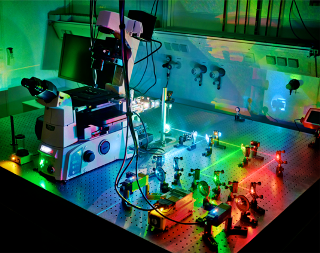Apr 25 2018
DNA origami is a technique for the design and self-assembly of complex molecular structures with precision in the nanometer scale. By utilizing the base-pairing interactions between single-stranded DNA molecules of known sequence, the method generates arbitrarily large numbers of intricate three-dimensional nanostructures with predefined shapes.
The technique possesses immense potential for an extensive range of applications in the research fields of biophysics and fundamental biology. Hence, researchers are already employing DNA origami for the development of functional nanomachines. Here, it is crucial to be able to characterize the quality of the assembly process.
Currently, a team headed by Ralf Jungmann, Professor of Experimental Physics at LMU Munich and Head of the Molecular Imaging and Bionanotechnology lab at the Max Planck Institute for Biochemistry (Martinsried), has reported a significant progress in this area. In Nature Communications, an online journal, he and his team have elaborated on a mode of super-resolution microscopy that allows the individual visualization of all the strands within these nanostructures.
This has enabled them to conclude that the assembly advances in a robust manner under different conditions; however, the probability of the efficient incorporation of a particular strand will depend on the precise position of its target sequence in the developing structure.
 Super-resolution microscopy. With DNA-PAINT, it is possible to visualize all the strands in DNA nanostructures individually. (Image credit: Maximilian Strauss, Max Planck Institute for Biochemistry)
Super-resolution microscopy. With DNA-PAINT, it is possible to visualize all the strands in DNA nanostructures individually. (Image credit: Maximilian Strauss, Max Planck Institute for Biochemistry)
Fundamentally, in order to assemble DNA origami structures, long single-stranded DNA molecule (the “scaffold” strand) are allowed to interact with a set of shorter “staple” strands in a controlled, predefined fashion. The latter bind to particular (“complementary”) stretches of the scaffold strand, progressively folding it into the preferred form.
“In our case, the DNA strands self-assemble into a flat rectangular structure, which serves as the basic building block for many DNA origami-based studies at the moment,” noted Maximilian Strauss, joint first author of the new paper, along with Florian Schüder and Daniel Haas. The researchers could visualize nanostructures with extraordinary spatial resolution as well as image each of the strands in the nanostructures using a super-resolution technique known as DNA-PAINT.
“So we can now directly visualize all components of the origami structure and determine how well it put itself together,” stated Strauss.
The so-called DNA-PAINT technique itself also exploits the specificity of DNA-DNA interactions. In this case, short “imager” strands connected to dye molecules that couple with complementary sequences are used for the identification of sites that are available for binding. The transient but repetitive interaction of the imager strands with their target sites results in a “blinking” signal.
By comparing the information in the individual fluorescence images, we are able to attain a higher resolution, so that we can inspect the whole structure in detail. This phenomenon can be understood as follows. Let’s say we’re looking at a house with two illuminated windows. Seen from a certain distance, it appears as if the light is coming from one source. However, one can readily distinguish between the positions of the two windows if the lights are alternately switched on and off.
Maximilian Strauss
Thus, the technique enables the researchers to precisely establish the positions of the bound staple strands. Moreover, the specific blinking signal emitted by imager strands shows the sites that are accessible for binding.
The results acquired by using the DNA-PAINT method showed that changes in various physical parameters—including the overall speed of structure formation—do not greatly affect the general quality of the assembly process. On the other hand, while its efficiency can be improved by using additional staple strands, not all strands were found in all of the nanoparticles formed, that is, some available sites were unoccupied in the final structures.
When assembling nanomachines it is therefore advisable that the individual components are added in large excess and the positions of the modifications chosen in accordance with our mapping of incorporation efficiency.
Maximilian Strauss
Therefore, the DNA-PAINT technique offers a means to optimize the fabrication of DNA nanostructures. Moreover, the authors expect the technology to hold immense potential in the field of quantitative structural biology, by enabling the researchers to directly measure the essential parameters, including the labeling efficiency of nucleic acids, cellular proteins, and antibodies.